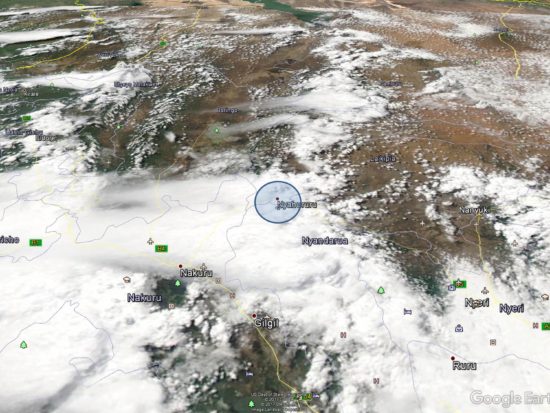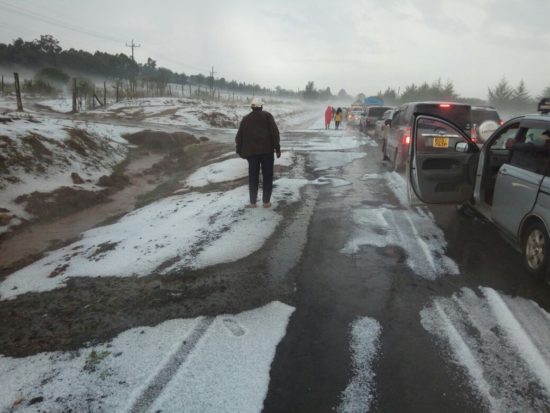There is much internet buzzing about “snow” in Kenya yesterday, and its connection to climate change.
Here’s what the event looked like on a road near Nyahururu, Kenya, which is on a plateau around 7,800 ft. elevation, and is positioned right on the equator:
If you click to get the full-size photo, you will notice that the ditch is running with water, and there is fog just above the ice. This means there was heavy rain with the event, and that the air is relatively warm and humid, and the ice on the ground is cooling the air to below the dewpoint, causing the fog.
This was a hailstorm, not “snow”.
Here’s what the area looked like from the MODIS instrument on a NASA satellite:

MODIS satellite imagery of central Kenya on July 4, 2017 showing thunderstorm clouds. Three successive satellite passes showed the storms growing at this time and moving eastward (to the right).
Those are thunderstorm clouds, not snow-producing clouds. Mountain hikers are familiar with summer storms producing small hail.
The GFS weather forecast model fields for yesterday showed that there was no cold air mass intrusion from high latitudes. The air mass temperature was near normal. At this latitude, you would have to go up to around 18,000 ft altitude to experience actual “snow”, which sometimes falls on the summit of Mt. Kenya (~17,000 ft.), and frequently on Kilimanjaro (~19,000 ft.)

 Home/Blog
Home/Blog





This means there was heavy rain with the event, that the air is relatively warm and humid, and the ice on the ground is cooling the air to below the dewpoint, causing the fog. garages
Does it usually snow there? I haven’t heard of snowing incidents in Kenya. garden mole
Thank you for providing this information. It’s important to distinguish between hail and snow, as they are formed through different processes and have different implications for climate change. While hailstorms are not uncommon in Kenya during the rainy season, snowfall at lower elevations is a rare occurrence in tropical regions. expertise
Thank you for providing this information. It is important to accurately distinguish between different types of precipitation, especially when there is speculation about its relationship to climate change. In this case, it seems that the event was a hailstorm, rather than actual snowfall. http://www.flex.storage/